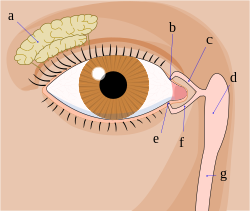EMOTIONAL TEARS IS HEALING
Psalms 126:5-6
They that sow in tears shall reap in joy. He that goeth forth and weepeth, bearing precious seed, shall doubtless come again with rejoicing, bringing his sheaves with him.

Anatomy of lacrimation, showing
a) Lacrimal gland
b) Superior lacrimal punctum
c) Superior lacrimal canal
d) Lacrimal sac
e) Inferior lacrimal punctum
f) Inferior lacrimal canal
g) Nasolacrimal canal
Lacrimation, or lachrymation, (from Latin lacrima, meaning "tear") is the secretion of tears, which often serves to clean and lubricate the eyes in response to an irritation of the eyes. Tears formed through crying are associated with strong internal emotions, such as sorrow, elation, emotion, awe or pleasure. Laughing or yawning may also lead to the production of tears.
Some modern therapy movements such as Re-evaluation Counseling teach that crying is beneficial to health and mental well-being, encouraging it positively.An insincere display of grief or dishonest remorse is sometimes called crocodile tears in reference to an Ancient Greek anecdote that crocodiles would pretend to weep while luring or devouring their prey.In addition, in medical terms, someone is said to have crocodile tears syndrome as an uncommon consequence of recovery from Bell's palsy, in which faulty regeneration of the facial nerve causes sufferers to shed tears while eating.
The phrase "having a good cry" suggests that crying can actually make you feel physically and emotionally better, which many people believe. Some scientists agree with this theory, asserting that chemicals build up in the body during times of elevated stress. These researchers believe that emotional crying is the body's way of ridding itself of these toxins and waste products.
a study conducted by the Weizmann Institute of Science in Rehovot, Israel, emotional tears from women have been found to reduce sexual arousal in men. Also, emotional tears are made up of a different chemical component than those evoked by eye irritants and can relay chemical messages to others. The change in sex drive could be attributed to a drop in testosterone provoked by the tear chemicals, reducing aggression. In the animal world, it has been found that some blind mole rats rub tears all over their bodies as a strategy to keep aggressive mole rats away.
Tears are continually produced in small quantities by the Tear Glands, which are located on the outer side of each eye, slightly above the eye and underneath the eyelid. Tears, which are spread evenly over the front surface of the eye during blinking, clean and lubricate the eye. An important component of tears is lysozyme, a chemical that inhibits bacterial growth on the eye's surface. Some of the tears evaporate, but the remainder are drained into the nose through the Tear Duct, keeping the nose moist. Lysozyme from the tears prevents bacterial growth in the nose as well.
Another interesting discovery about the content of tears was made by Dr. William H. Frey II, a biochemist at the St. Paul-Ramsey Medical Center in Minnesota. He and his team analyzed two types of tears: the emotional ones (crying when emotionally upset and stressed) and the ones arising from irritants (such as crying from onions). They found that emotional tears contained more of the protein-based hormones, prolactin, adrenocorticotropic hormone, and leucine enkephalin (natural painkiller), all of which are produced by our body when under stress. It seems as if the body is getting rid of these chemicals through tears. That explains why we usually feel better after a good cry. So, there you go. Cry as much as you want - it is probably good for you. But no cheating by inducing crying with onions. Your tear glands know the difference.
Tear composition varies from tear types. Mainly, tears are composed of water, salts, antibodies and lysozymes (antibacterial enzymes). According to a discovery by Dr. William H. Frey II, a bio-chemist from St. Paul Ramsey medical center in Minnesota, the composition of tears caused by emotion differs from that of tears as a reaction to irritations, such as onion fumes, dust or allergy. Emotional tears are composed of more protein-based hormones, such as prolactin, adrenocorticotropic, and leucine enkephalin (a natural pain killer), which is suggested to be the mechanism behind the experience of crying from emotion making an individual feel better.



Comments
Post a Comment